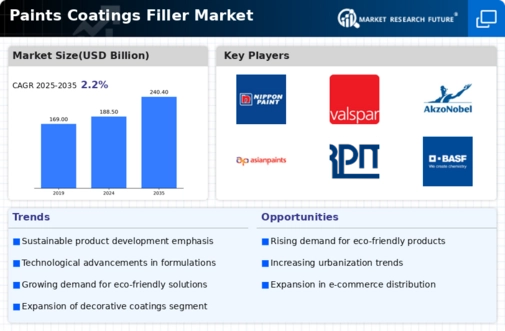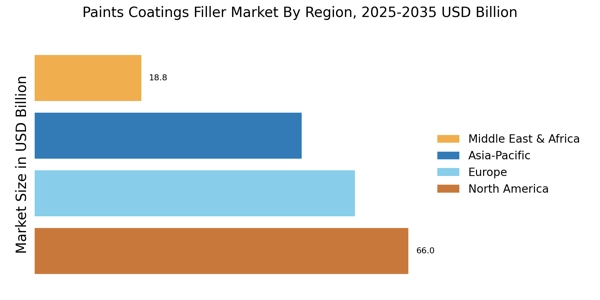Rising Construction Activities
The Paints Coatings Filler Market is experiencing a notable surge due to the increasing construction activities across various regions. As urbanization accelerates, the demand for residential and commercial buildings rises, leading to a higher requirement for paints and coatings. According to recent data, the construction sector is projected to grow at a compound annual growth rate of approximately 5% over the next few years. This growth is likely to drive the demand for fillers and coatings, as they are essential for surface preparation and finishing. Furthermore, the expansion of infrastructure projects, including roads and bridges, further contributes to the market's expansion. Consequently, the Paints Coatings Filler Market is poised to benefit significantly from these trends, as construction companies seek high-quality products to meet the increasing demands of their projects.
Increased Focus on Aesthetic Appeal
The Paints Coatings Filler Market is witnessing a shift towards enhanced aesthetic appeal in both residential and commercial spaces. Consumers are increasingly prioritizing the visual aspects of their environments, leading to a higher demand for decorative paints and coatings. This trend is supported by the growing influence of interior design and home improvement shows, which inspire homeowners to invest in quality finishes. Market data indicates that decorative paints account for a substantial share of the overall paints market, with a projected growth rate of around 6% annually. As a result, manufacturers in the Paints Coatings Filler Market are innovating to offer a wider range of colors, textures, and finishes, catering to the evolving preferences of consumers. This focus on aesthetics not only drives sales but also encourages the development of new products that meet the diverse needs of the market.
Environmental Regulations and Sustainability
The Paints Coatings Filler Market is increasingly influenced by stringent environmental regulations aimed at reducing volatile organic compounds (VOCs) and promoting sustainable practices. Governments and regulatory bodies are implementing policies that encourage the use of eco-friendly materials in construction and renovation projects. This shift is prompting manufacturers to innovate and develop low-VOC and water-based products that align with these regulations. Market analysis suggests that the demand for sustainable paints and coatings is expected to grow significantly, with a projected increase of approximately 7% in the next few years. As consumers become more environmentally conscious, the Paints Coatings Filler Market is likely to see a rise in the adoption of green products, which not only comply with regulations but also appeal to a growing segment of eco-aware consumers.
Growing DIY Culture and Home Renovation Trends
The Paints Coatings Filler Market is experiencing a boost from the growing do-it-yourself (DIY) culture and an increase in home renovation activities. As more individuals take on home improvement projects, the demand for paints and fillers is rising. This trend is particularly evident among millennials and younger generations, who are more inclined to personalize their living spaces. Market Research Future indicates that the DIY home improvement market is expected to grow at a rate of approximately 8% annually, further fueling the demand for paints and coatings. Retailers are responding by expanding their product offerings and providing resources to assist DIY enthusiasts. Consequently, the Paints Coatings Filler Market stands to gain from this trend, as consumers seek high-quality products that enable them to achieve professional results in their home projects.
Technological Innovations in Product Development
The Paints Coatings Filler Market is benefiting from rapid technological advancements that enhance product performance and application processes. Innovations such as nanotechnology and advanced polymer formulations are leading to the development of high-performance coatings that offer superior durability, adhesion, and resistance to environmental factors. These advancements are particularly relevant in sectors such as automotive and industrial applications, where performance is critical. Market data indicates that the adoption of advanced coatings is expected to increase, with a growth rate of around 5% projected over the next few years. As manufacturers continue to invest in research and development, the Paints Coatings Filler Market is likely to witness a wave of new products that meet the evolving demands of various industries, thereby driving market growth.


















Leave a Comment